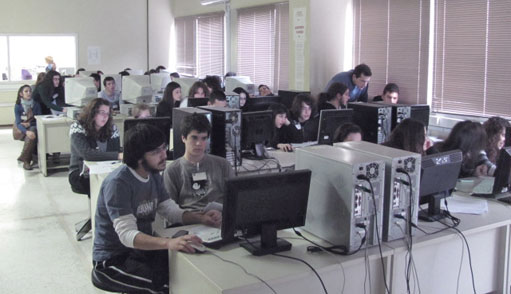
ATLAS e-News
23 February 2011
Reeling in the future physicists
1 November 2010

To people 'on the outside', even your close family and friends, what it means to be a working particle physicist – what it is you do all day, and why – can be somewhat ethereal and difficult to pin down. A new outreach project, part of the EU Science in Society initiative, is different to similar projects that have gone before. It is aimed squarely at teachers, training them how to convey the methods and motivations behind particle physics in an accessible and engaging way in the classroom.
The project comes under the wider scope of 'Pathway' – an EU initiative promoting inquiry-based learning, that pools expertise in the fields of science education, scientific research, policy-making and curriculum development, from 25 worldwide institutions including CERN. Pathway is intent on modernising the way that scientific knowledge and competence is developed in learners, focussing on 'higher level cognitive skills' like concept formation, modelling and problem solving.
ATLAS already has strong education foundations in the form of the Learning with ATLAS@CERN Repository, a catalogue of videos, games, animations, student projects and much more. There is even a package allowing students to download it all to their mobile phones for browsing on the move.
Over the summer, 22 teachers from across Europe helped design lesson plans incorporating and augmenting the existing material in the Repository. Now, teachers can access these – searchable by topic and age range (from six-year-olds right up to adults) – in six different languages. The site also allows teachers to upload and share their own tried-and-tested educational materials.
"Just imagine that the kids tell [their teacher], 'yesterday I read in the newspaper about the LHC'. Instead of scratching their head, the teacher can say, 'tomorrow, I'll have a lesson about the LHC'," smiles Christine Kourkoumelis. Christine, a professor at the University of Athens, got heavily involved with outreach activities three years ago, when her creation for visually interacting with, probing, and interpreting event images, HYPATIA, was adopted for use in the popular student Masterclasses. Under Pathway, she is responsible for promoting school-research centre collaborations.
Over the next three years, Learning with ATLAS@CERN will instigate a gearshift by actually showing (often overworked, underpaid, and curriculum-bound) teachers how these online resources can best be used in their classrooms. Inspiring the teachers is the key to making sure this rich reserve of information is used to its full potential.
"We want to change their whole way of teaching, to inquiry-based science teaching," says Christine. "We want to disseminate what we're doing here to the teachers – through visits to CERN and through our visits to schools – and open the window to live scientific experiments and to the personalities and stories of working scientists."
In contrast to the existing Teachers' Program, Learning with ATLAS@CERN will follow closely how the teachers end up using the training and information, as part of Pathway's greater 'science in society' mission.
The Austrian Ministry of Education, one of the nine-strong Learning with ATLAS@CERN consortium, piloted the lesson plan scheme last September with resounding success in Austrian schools and science centres. The scheme rolls out across Europe in early 2011.
Pathway will need ATLAS volunteers to help with every aspect of the teachers' training, from lectures through to tours. If you're interested in contributing to the next generation's education, please contact Markus Nordberg at CERN or Christine Kourkoumelis.
 Ceri PerkinsATLAS e-News
|